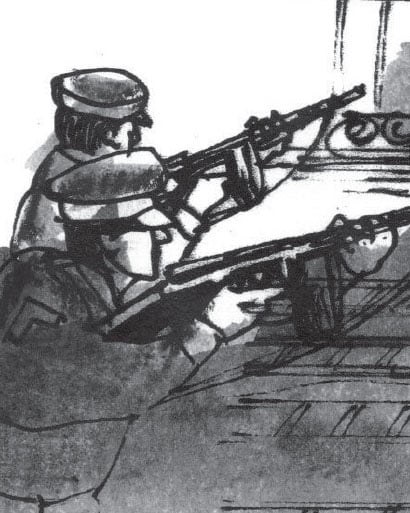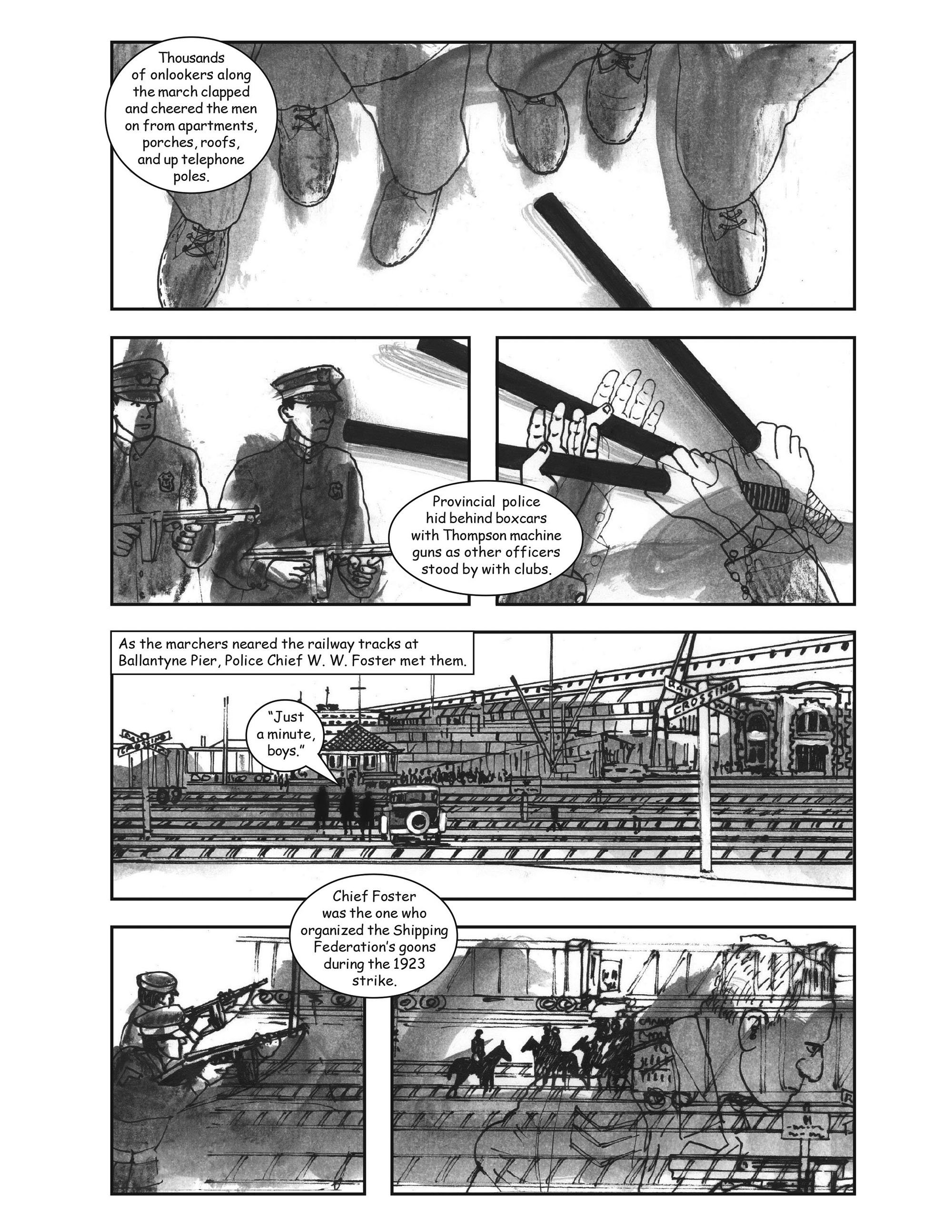

[Editor’s note: This Labour Day week The Tyee is daily publishing excerpts from Drawn to Change: Graphic Histories of Working-Class Struggle, a new comics-style collection of stirring moments in Canadian labour history. Today’s offering is from the chapter “The Battle of Ballantyne Pier: An Injury to One Is an Injury to All,” written and drawn by David Lester.
At the depth of the Great Depression, on June 18, 1935, a long-simmering conflict on Vancouver’s waterfront reached a flash point as militant unionists joined unemployed protesters to form a 5000-strong march for work, wages, a more radical union, and an end to military control of relief camps. Vancouver’s mayor Gerry McGeer vowed to “mobilize 10,000 men to keep the port open and rid the city of the Red Menace.” Police confronted the demonstrators, beating, tear-gassing and raking them with buckshot. Many of the 60 injured were veterans of the First World War. The page excerpted below recounts the action.
Bloodied but not bowed, having been denied their rights to picket, union members stayed off the job. But the company would not negotiate, militancy waned and the strike ended as winter set in. Lester, whose grandfather was a longshore worker at the time, notes, “The struggle for social justice is not always a linear narrative. It is far messier….” He concludes, “The battle of Ballantyne Pier was not a defeat. It was a victory of workers in the fight for a better world.”
For more context, farther down, read Simon Fraser University researcher Dale McCartney’s “Organizing in the Hardest of Times.” The work of Lester and McCartney is excerpted with permission by Toronto-based publisher Between the Lines.]
ORGANIZING IN THE HARDEST OF TIMES
Essay by Dale McCartney
David Lester’s project highlights an exceptionally important moment in the history of Canadian workers. Long overshadowed by the On-to-Ottawa Trek, which happened at roughly the same time, the Battle of Ballantyne Pier was the culmination of more than a decade of union organizing on the Vancouver waterfront. It stands out as a singular event, but also one example of a broader worker-led fight back in the 1930s. For unionists today, it is a reminder that there have been periods in the past in which employers have been intractable, the state has been an enemy, and organizing has seemed impossible, and yet, as Lester shows us, progress is possible.
Longshore workers had been militant pretty much since the docks opened in Vancouver. And so in 1923 the employers on the shore turned to a new method of pacifying their employees, the company union. Company unions offered the façade of union membership to workers, but the actual control of the union rested in the hands of the employer. They were first a public relations initiative, started after the Ludlow Massacre of 1912 by a Rockefeller family concerned about its public image. Like contemporary human resource approaches, they used the power of names to disguise a system that remained largely unchanged. Similar to modern companies who call their workers “team members,” “associates” or “partners” — yet still treat them as expendable employees — company unions were set up to allow employers to insist they respected their employees, even as the unions worked to placate workers rather than represent them.
As Lester shows us, longshore workers (including his grandfather Frederick Lester) overcame this tactic, again and again electing leaders like Ivan Emery, who forced the company unions to become actual unions, representing the interests of their members instead of the interests of the employers. These campaigns bear some resemblance to contemporary campaigns for better conditions in the retail and fast food sector, as the organizing was happening outside of the broader union movement at first, and was driven by the workers themselves. Despite enormous obstacles, workers still organized and fought for their rights.
Another important lesson that Lester’s graphic history teaches us is that the state is often an opponent of progressive change for workers. The On-to-Ottawa Trek is an example, as it resulted in an RCMP attack on the protestors in Regina, similar to the Vancouver Police Department attack that Lester draws so movingly. The era was characterized by state neglect of workers interests, and open hostility from the government toward unions. Much like today, the government consciously positioned the interests of workers as different than the interests of the public.
Lester’s account of the battle is also important because he humanizes the activists involved, and reminds us that people just like us overcame these challenges in the past. By telling the story through the eyes of his grandfather, Lester shows how everyday people can contribute to moments of great historical importance. Similarly, the gritty realism of the images captures recognizable sites in Vancouver, allowing us to see ourselves in the efforts of the longshore workers, and prompting us to recognize modern-day efforts to make Canada more just as part of a long history of working class struggle.
Workers today find themselves facing challenges that their parents had thought permanently overcome. Declining wages, lengthening workdays, and the loss of opportunities for advancement or meaningful work are only the start. As unions decline and governments beholden to free trade agreements continue to break down labour laws, workers confront an unregulated and unprotected future. But Lester has shown us with this comic book that there are victories to be won even when workers are organizing in difficult conditions.
For these reasons, Lester’s graphic history is both wonderful and timely. As the contemporary labour movement confronts declining density, anti-union employers who use everything from propaganda videos to targeted firings to prevent unionization, and a state that is neglectful at best and openly hostile at worse, it is important for contemporary activists to look back at periods with similar challenges.
It is easy to forget that some of the basic rights modern workers take for granted today were won through confrontations like the Battle of Ballantyne Pier, and won by people like Lester’s grandfather. This beautiful graphic history reminds us of the importance of past battles, and inspires us to believe we can win them again. ![]()
Read more: Labour + Industry















Tyee Commenting Guidelines
Comments that violate guidelines risk being deleted, and violations may result in a temporary or permanent user ban. Maintain the spirit of good conversation to stay in the discussion.
*Please note The Tyee is not a forum for spreading misinformation about COVID-19, denying its existence or minimizing its risk to public health.
Do:
Do not: